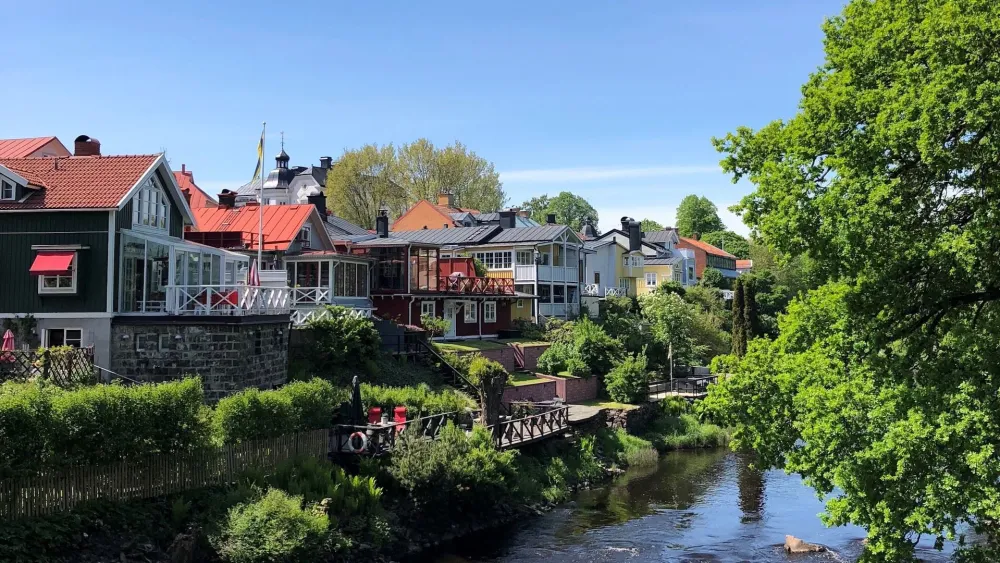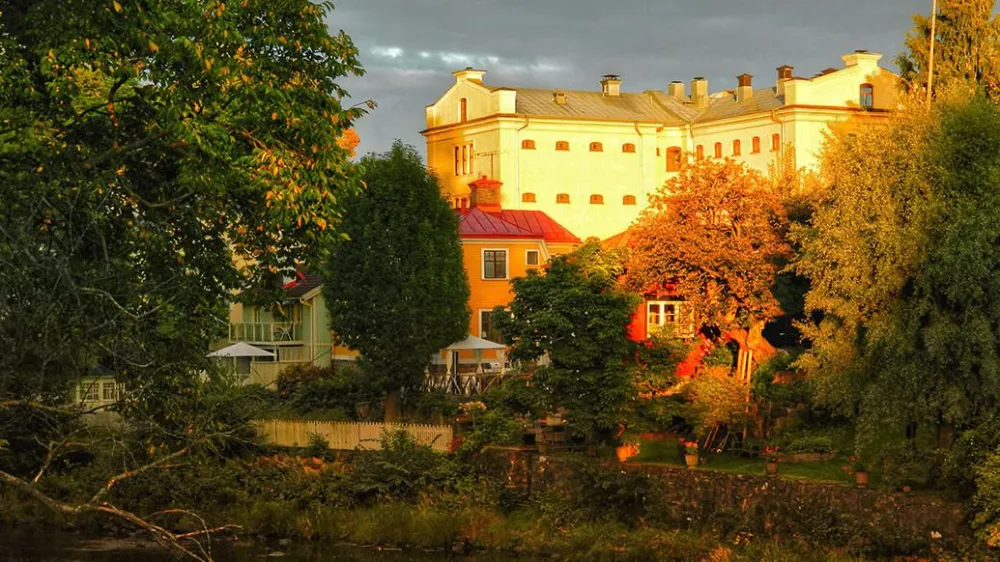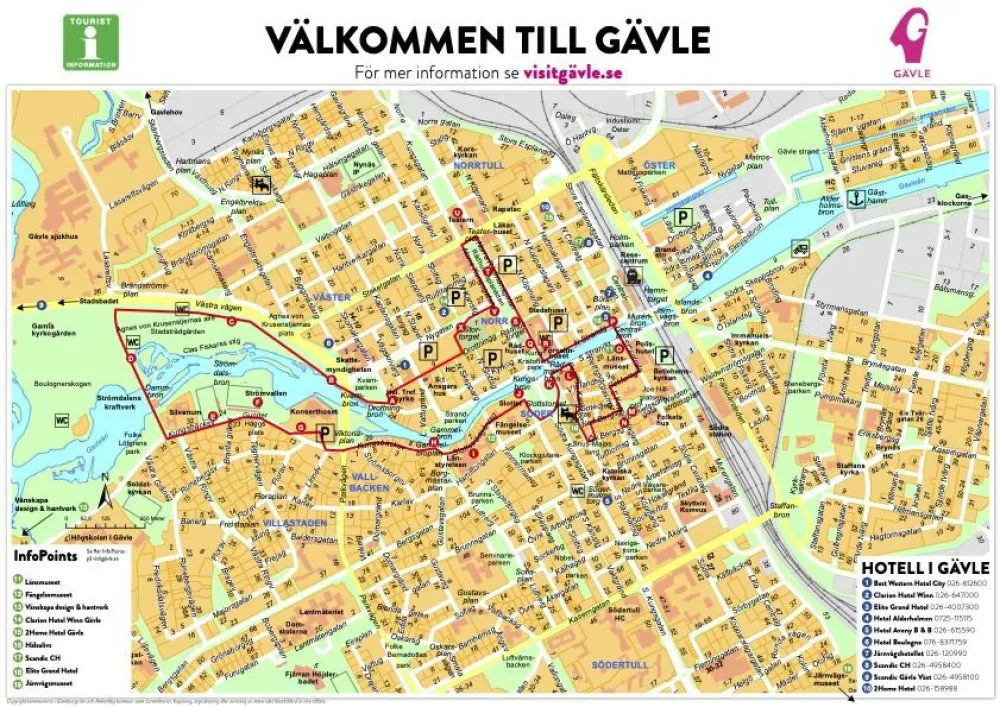City walk in Gävle
On this page, you’ll find information about the red dots on our city map.
Download it by clicking in the slideshow above, then on the map image and save it, or pick it up at one of our InfoPoints.
A. Holy Trinity Church
There has likely been a church at this site since the 15th century when Gävle became a city. It is believed that Gävle was founded here, at the location of the Holy Trinity Church. The church gained its current design during Sweden’s period as a great power in the mid-1600s, although the tower wasn’t completed until 1781.
The Holy Trinity Church is one of the few buildings north of the river that was spared during the great fire of 1869.
Note: The tower leans by a full metre at the ridge of the nave. It already leaned slightly during construction due to the sandy clay soil. Eventually, the movement was stopped – a project financed through an extra tax on coffee and sugar.
B. “Five Musical Spirits” by Carl Milles
Created in 1948 and placed in the City Garden in 1983. The word “genius” originally comes from Latin and can be translated as benevolent spirits. They can also be seen as angels. Flying angels were one of Milles’ cherished themes. Replicas of the sculptures can be found in several other locations, such as Millesgården in Lidingö.
C. Agnes von Krusenstjerna’s Avenue
The avenue was laid out in 1842 by alderman Carl Valley and named after the author in 1987. Agnes von Krusenstjerna (1894–1940) lived for a short time in Gävle, and the city’s setting appears in several of her works.
In her 1922 novel “Tony Grows Up,” the avenue is described.
D. City Garden and Boulogner Forest
Gävle’s city park is actually two parks. The City Garden was established in the 1840s. Between the City Garden and the New Cemetery was a beautiful pine grove called Kroknäs Hage. In 1865, Boulogner Forest was created there as an extension of the City Garden. The inspiration was, of course, the Bois de Boulogne in Paris.
Linked by waterways and walking paths, the two parks form a unified whole. There’s a café, mini-golf, and popular playgrounds with barbecue facilities. You’ll also find a range of statues and sculptures.
E. Silvanum
The building was originally designed for the forest museum Silvanum and was completed in 1961, inaugurated by King Gustaf VI Adolf. Architect Sven Henrik Wranér, in collaboration with Danish architect Erik Herlöw, created this fine example of transparent, light modernism – one of Gävle’s most interesting buildings.
Silvanum was in operation for over forty years, and many locals remember exhibitions, craft fairs, and the famous seasonal birdsong that could be heard through headphones.
Although the museum no longer exists, the site remains strongly rooted in local memory.
F. Strömvallen
As early as 1903, Gävle had a modern sports ground on what was then called the Matton fields in Strömdalen. The site was gradually expanded and modernised. The stands were designed by Gävle-born Erik Vestergren, and the “new” sports ground was inaugurated in 1923, changing the name from Strömdalen to Strömvallen.
Note: The statue of the runner outside Strömvallen has stood there since 1947. It depicts the legendary Gävle-born runner Gunder Hägg, sculpted in bronze by Olof Ahlberg.
G. Gävle Concert Hall
The concert hall was inaugurated in January 1998 on the site of the old bathhouse, Strömbadet. The architect was Bo Karlberg, who also designed the Gothenburg Opera House. The circular building is clad in 138,000 blue ceramic tiles and is home to the Gävle Symphony Orchestra.
There are two concert halls: Gevalia Hall with 820 seats and Bo Linde Hall with 170 seats. The building also houses a café and a large restaurant.
H. The Old Bridge
Gävle’s oldest bridge and, until the 1580s, the only crossing over the Gavle River. During the city fire in 1869, the bridge was damaged and demolished to prevent the fire from spreading south.
The current bridge dates back to 1869–70.
I. The Swedish Prison Museum – A museum in two prisons
Slottshäktet from 1732 and the Cell Prison – Hotel Hamilton from 1847. In an authentic setting, you can explore Sweden’s history of “crime and punishment.” In the Slottshäktet, prisoners were held together in dark, cold rooms, many awaiting harsh and intimidating punishments.
When the cell prison system was introduced in the 1840s, public shaming and corporal punishment were gradually replaced by prison sentences and forced labour. Prisoners now had individual cells and were not allowed to speak to each other. A large face mask was worn when inmates were taken outside to prevent them from seeing one another.
J. Gävle Castle
On the south side of the Gavle River stands Gävle Castle. Built in 1593 by King John III, it once looked like a fairytale castle with turrets and towers. Today, only the thick castle walls remain from that era.
Legend has it that in 1727, a maid was climbing to the attic to collect dry laundry with a candle in hand. The dry laundry caught fire, and the flames spread rapidly. The towers and much of the castle burned down.
When the castle was rebuilt in the mid-1700s, no new towers were added – they were considered outdated. Architect Carl Hårleman was commissioned for the rebuild, and since then, the castle has served as the county governor’s residence.
They say the maid still haunts the castle, so keep your eyes open – she might appear in one of the windows.
Note: Look for the inscription above the large iron gate facing Slottstorget.
K. The Gävle Goat
During December and January, the world’s largest straw goat stands proudly in Slottstorget (temporary location at Rådhusesplanaden). This giant goat is Gävle’s most famous icon. It is inaugurated every year on the first Sunday of Advent and stands 13 metres tall, 7 metres long, and weighs 3 tonnes.
The first goat was erected in 1966, and in 1985 it entered the Guinness Book of Records.
L. Agnes Cultural Centre
Gävle’s new cultural hub where culture, entertainment, and education are accessible to all and open every day of the year. Welcome to Agnes Cultural Centre, offering activities for all interests.
M. The Joe Hill House
Joe Hill was born Joel Hägglund in Old Gävle in 1879. He moved to the United States in 1902 and changed his name to Joe Hill. He wrote songs and poems and fought for workers’ rights.
He was accused of murder and executed in 1915, though many believe he was innocent. Today, his childhood home is a museum. In the memorial room upstairs, you’ll find copies of his final letters home.
N. Old Gävle
Wander the cobbled streets of this historic district south of the river. Most of the houses date back to the 1700s and have survived both fires and demolition.
Back then, the area was home to sailors and craftsmen, pigs roamed the alleys, and the smell from outdoor toilets was overwhelming.
Here you’ll also find the restaurant Söderhielmska Gården, featured in the film “Black Jack.”
O. County Museum
The Rettig family owned a tobacco factory in Gävle and also ran shipyards and shipping businesses in the 1800s. The museum’s story begins in 1933 with the passing of Antonie Rettig, who left behind “The John and Antonie Rettig Museum Funds for the City of Gävle.”
The donation included a large sum of money, worth many millions in today’s value. The museum was built using this donation. The building, designed by city architect Sven Wranér, was completed in 1940 and originally named Gävle Museum.
In accordance with the donor’s wishes, the design was inspired by the Copenhagen palace of Antonie Rettig’s sister.
The museum houses a unique art collection from the 1600s to today, along with exhibitions, a café, and a shop.
P. Old Grand Hotel (Elite Grand Hotel)
This beautiful hotel was designed by architect Ture Stenberg for the grand Gävle Exhibition in 1901. When it opened, it was one of the largest hotels outside of Stockholm.
For 40 years it served as a hotel, later hosting a cinema, banquet hall, bank, theatre, chocolate shop, and cultural school.
In 1970, Old Grand was threatened with demolition to make way for a parking garage. A preservation campaign saved the building.
On 17 August 2011, Bicky Chakraborty of Elite Hotels acquired the property with the aim of restoring the Grand Hotel – and now we see the result.
Q. Town Hall
After the old town hall burned down in 1776, C.F. Adelcrantz designed a new one in neoclassical style. Completed in 1790, the building was partially funded by King Gustav III, who donated a marble medallion portrait by Tobias Sergel and 4,500 riksdaler.
The 1869 fire destroyed the upper part, including the onion-shaped tower and most of the interior. The building was restored in the 1870s by royal architect F.G.A. Dahl, with changes to the façade, a steeper roof, and a more austere tower with clock faces.
R. City Hall
Built between 1803 and 1805 by Pehr Ennes as a private residence, it was bought by the city in 1848. Severely damaged in the 1869 fire, it was rebuilt between 1871 and 1874, designed by architect J.F. Åblom.
S. Goddess by the Hyperborean Sea
In May 1956, Eric Grate’s massive granite sculpture “Goddess by the Hyperborean Sea” was unveiled. The statue stands in front of Rådhustorget.
T. Hedberg’s Fountains
These two large fountains were created in 1880 by Carl Johan Dyferman and donated to the city by merchant Anders Magnus Hedberg, who lived next to the esplanade.
U. Gävle Theatre
Destroyed in the great fire of 1869, the theatre was rebuilt in 1878 based on drawings by Axel Fredrik Nyström.
The building was inspired by the Paris Opera and resembles the Royal Opera in Stockholm, which opened 20 years later.
The façade features busts of Shakespeare, Molière, and Mozart.
Back then, the theatre had two cafés – a basic one for the poor and a luxurious one with golden walls for the wealthy.
In 1983, a major extension was added to the north side for the Gävle Folk Theatre. Today, Gävle Theatre hosts touring performances, including many from the National Theatre.
Note: Look closely at how Shakespeare’s and Molière’s names are spelled above the main entrance. Both are misspelled and have been that way for over 125 years.
V. Old Hypotekshuset
This stately building was erected by Gefle City Savings Bank in 1899 using Kolmården marble and red granite. Architect Aron Johansson also designed the Swedish Parliament building in Stockholm.
Note: The inscription facing the square reads “Saved money is like earned, doubly valuable when nobly used.” The inscription facing Nygatan says, “Lazy hand brings poverty, diligent hand brings wealth.”
X. Stortorget
In the early 1900s, farmers sold meat directly from horse-drawn carts in the square. On 9 March 1900, 1 kg of wheat flour cost 25 öre, 1 kg of butter 170 öre, and 1 kg of perch 90 öre.
Today, Stortorget is a lively square with events like performances, Christmas tree celebrations, and market stalls.
You can buy everything from hot dogs to flowers, fruit, vegetables, and clothes. You can even buy fresh fish directly from local fishermen.
Don’t forget: Bring home a “kast” of smoked herring as a souvenir from Gävle. A “kast” means four herrings held in one hand.
- Free admission
- Child friendly
- All year
- City
- Kostnadsfritt
- Free admission
- Child friendly
- All year
- City
- Kostnadsfritt



